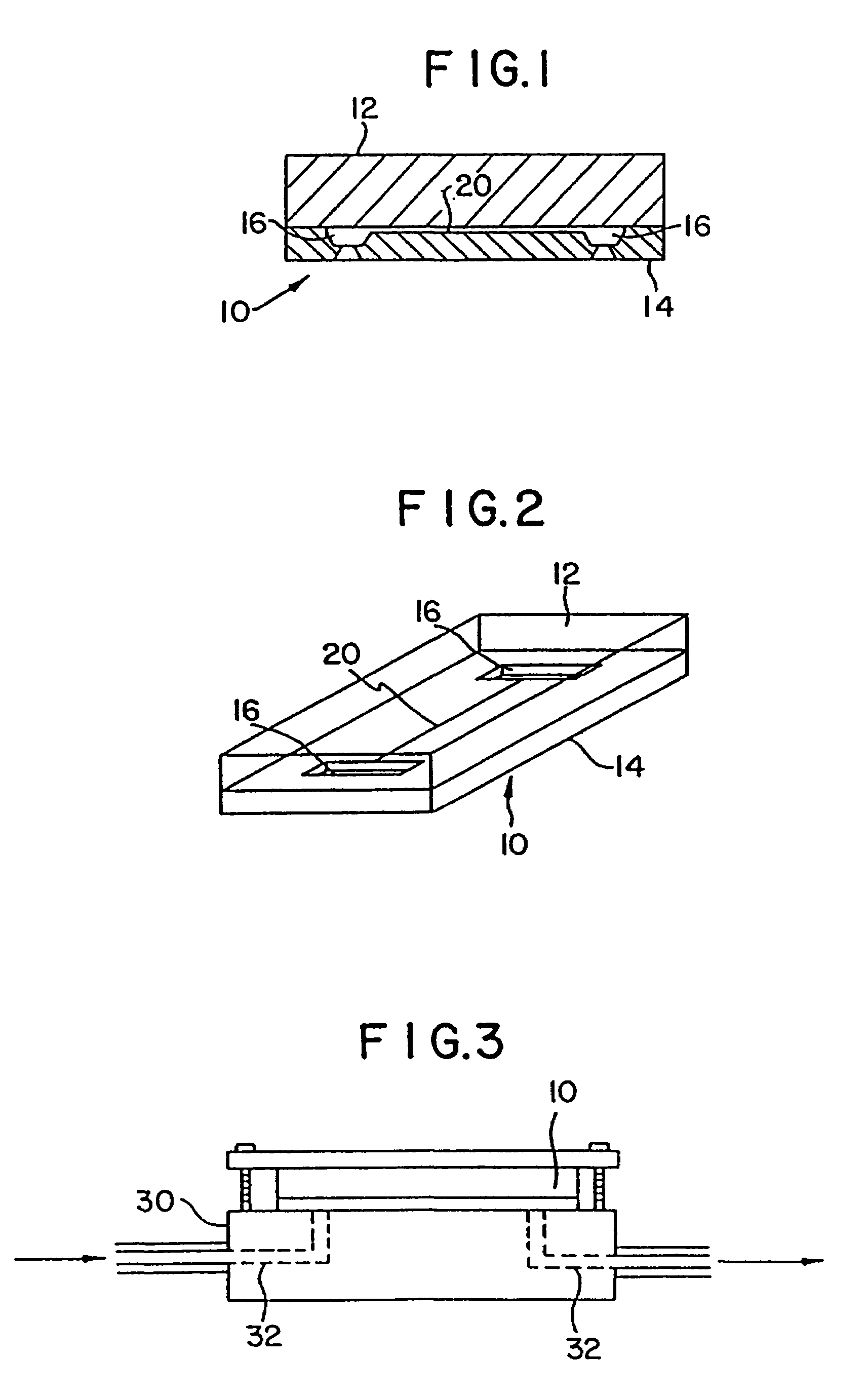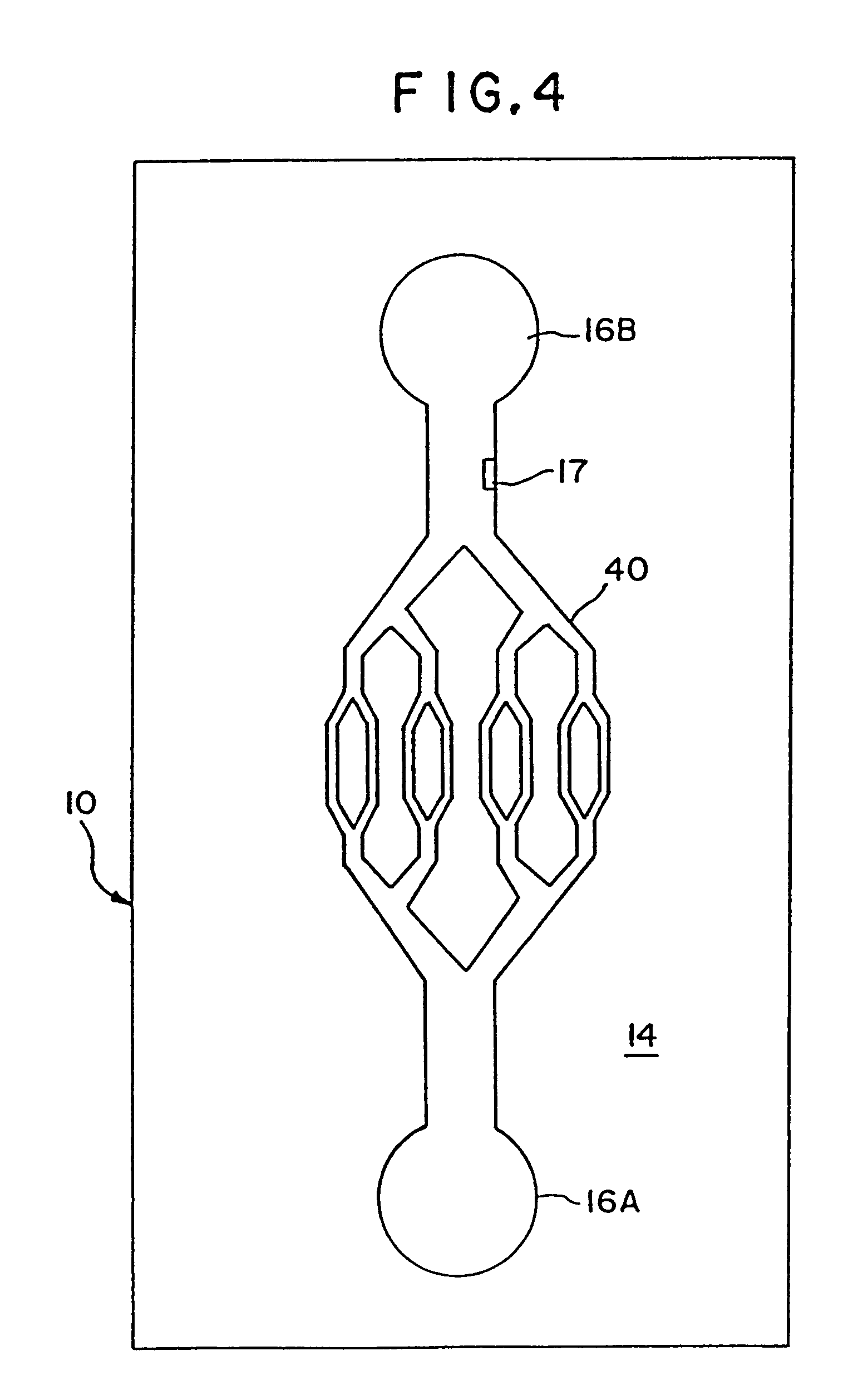Device and method for the detection of an analyte utilizing mesoscale flow systems
a flow system and flow device technology, applied in the field of analytical methods and apparatus, can solve the problems of not fully exploiting the potential of mesoscale structures in the life sciences, not producing data associated with an analytical device, and not fully exploring the potential of using mesoscale devices. , to achieve the effect of preventing contamination and ensuring sterilization
- Summary
- Abstract
- Description
- Claims
- Application Information
AI Technical Summary
Benefits of technology
Problems solved by technology
Method used
Image
Examples
example 1
[0076]Capillary agglutination of red blood cells and immobilized anti-A antiserum was examined in a series of silicon substrates 14 (shown schematically in FIG. 6), fabricated with flow channels 20 of varying width. The silicon substrates 1–5 included flow channels 20A and B with a depth of 10 μm and widths ranging from 20 to 300 μm (Table 2). The inside surface of the channels were coated with anti-A (1:10 dilution) by first filling the channel with the antibody (capillary action) and allowing it to dry. A Type blood (diluted 1:5) was then introduced into channel 20 from inlet port 16 by capillary action and the channel was observed visually using a microscope (Leitz Aristomet). Results are summarized in Table 2.
[0077]
TABLE 2DEPTHCHANNEL WIDTHSUBSTRATE #(μm)(μm)AGGLUTINATION110A:20 +B:40 +210A:60 +B:80 +310A:100+B:120+410A:150+B:200+510A:250+B:300+
example 2
[0078]A plastic-silicon hybrid was fabricated by attaching a plastic (3M transparency sheet) cover over the silicon substrate 14, which is microfabricated with flow channels 20 with entry ports 16 on opposite sides of the channel and a central detection chamber 22 (shown schematically in FIG. 7). A dilution of anti-A (in 0.05 M sodium bicarbonate pH 9.6) and a 1:10 dilution of Type A blood in saline were introduced via syringe using a holder into the entry ports 16 on opposite ends of the channel 20. The solutions mixed together in the central chamber 22 and agglutination was observed through the plastic cover by light microscopy. The results are summarized in Table 3.
[0079]
TABLE 3AGGLUTINATION INANTI-ADILUTIONCHANNELGamma Kit1:20 +Gamma Murine Mono1:20 +Gamma Human Dilution1:5 +Immucor Affinity pure1:100+Immucor Ascites1:100+
example 3
[0080]A plastic-silicon hybrid was fabricated by attaching a piece of plastic (3M transparency sheet) over a silicon substrate 14 etched with a mesoscale flow channel 20 having entry ports 16 microfabricated on opposite sides of the channel and a central mesoscale mixing chamber 22 (shown schematically in FIG. 7). A solution of mouse IgG (50 μg / mL in 0.05 M sodium bicarbonate pH 9.6) (SIGMA Cat. no. 1–5381) and a 1:20 dilution of goat anti-mouse IgG (H&L)—fluorescence carboxylate beads (Polysciences, Inc.) in PBS buffer were introduced via syringe using a holder into the entry ports on opposite ends of the channel. The solutions mixed together in the central chamber 22 and agglutination was observed through the transparent plastic cover by light microscopy.
PUM
| Property | Measurement | Unit |
|---|---|---|
| total volume | aaaaa | aaaaa |
| volume | aaaaa | aaaaa |
| depth | aaaaa | aaaaa |
Abstract
Description
Claims
Application Information
 Login to View More
Login to View More - R&D
- Intellectual Property
- Life Sciences
- Materials
- Tech Scout
- Unparalleled Data Quality
- Higher Quality Content
- 60% Fewer Hallucinations
Browse by: Latest US Patents, China's latest patents, Technical Efficacy Thesaurus, Application Domain, Technology Topic, Popular Technical Reports.
© 2025 PatSnap. All rights reserved.Legal|Privacy policy|Modern Slavery Act Transparency Statement|Sitemap|About US| Contact US: help@patsnap.com



